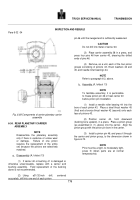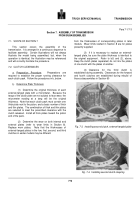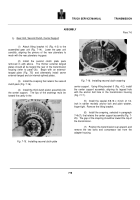TM-5-3805-254-14-P-2 - Page 780 of 894
TRUCK SERVICE MANUAL
TRANSMISSION
Para 7-1/7-3
Section 7.
ASSEMBLY OF TRANSMISSION
FROM SUBASSEMBLIES
7-1.
SCOPE OF SECTION 7
This
section
covers
the
assembly
of
the
transmission. It is arranged in a continuous sequence to
facilitate assembly. Certain illustrations will not always
illustrate the model being assembled, but, when the
operation is identical, the illustration may be referenced
and will correctly illustrate the procedure.
7-2.
CLUTCH CLEARANCES
a
.
Preparation Procedure.
Preparations are
required to establish the proper running clearance for
each clutch pack.
Follow the procedures in b, below.
b
.
Determine Plate Thickness
(1
)
Determine the original thickness of each
external-tanged plate with a micrometer.
Because the
tangs of the clutch plate are not subject to face wear, the
micrometer reading at a tang will be the original
thickness.
Note that each clutch pack must contain one
thick plate next to the piston, and a basic number of thick
and thin plates.
The combination of thick and thin plates
are selected to meet the prescribed clearance with the
clutch released. Install all thick plates toward the piston
end of the pack.
(2
)
Determine the wear on both internal and
external plates (refer to wear limits in Section 8).
Replace worn plates.
Note that the thicknesses of
external-tanged plates in the low, first, second, and third
clutches in earlier models may be different
from the thicknesses of corresponding plates in later
models.
Wear limits started in Section 8 are for plates
presently supplied.
(3
)
If it is necessary to replace an external-
tanged plate, be sure the plate thickness is identical to
the original equipment.
Refer to b(l) and (2), above.
Keep the clutch plates separated; do not mix the plates
of one clutch with the plates of another.
(4
)
Clearance
for
the
third
clutch
is
established during assembly.
Clearances for the forward
and fourth clutches are established during rebuild of
those subassemblies in Section 60
Back to Top




















